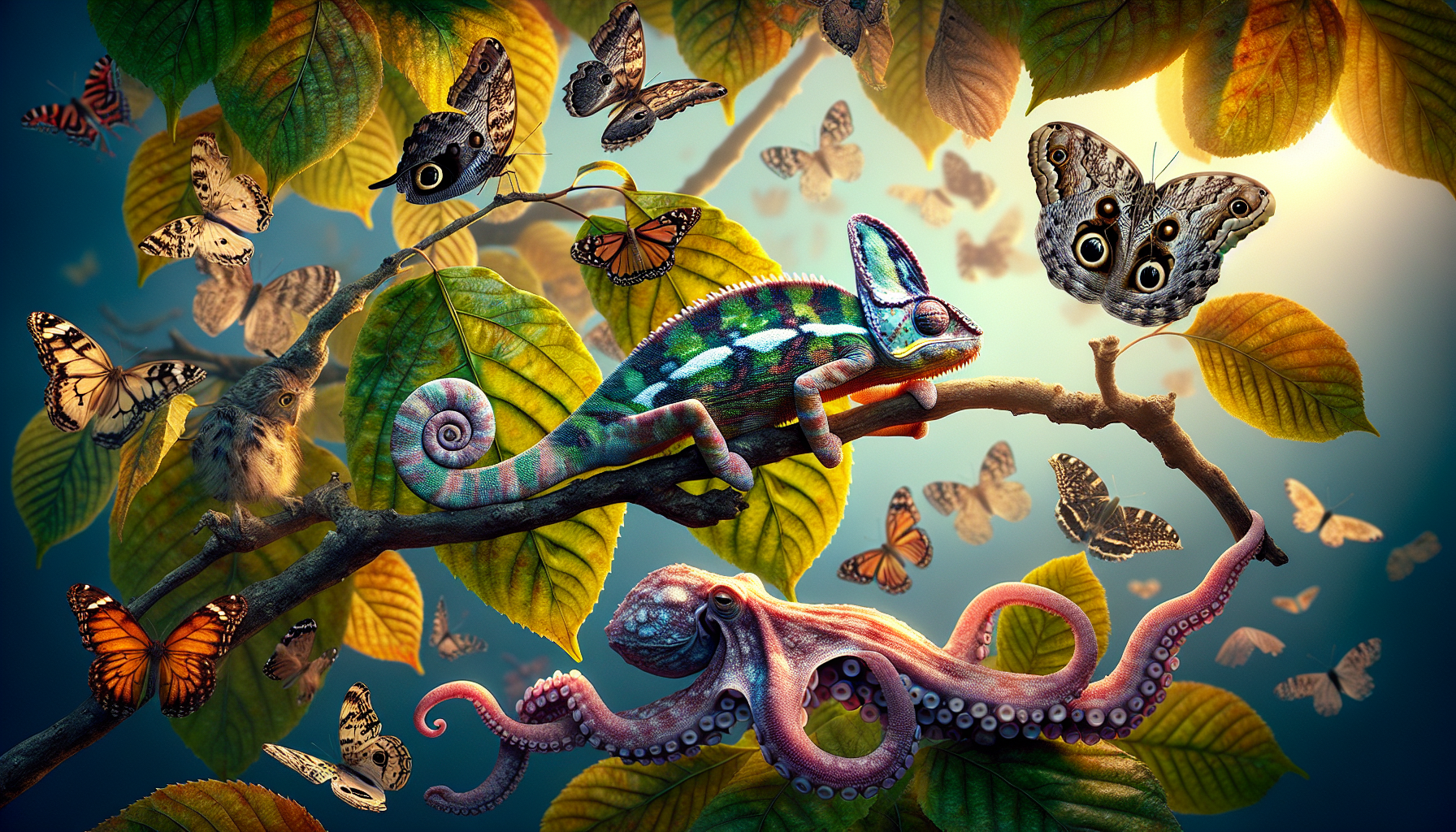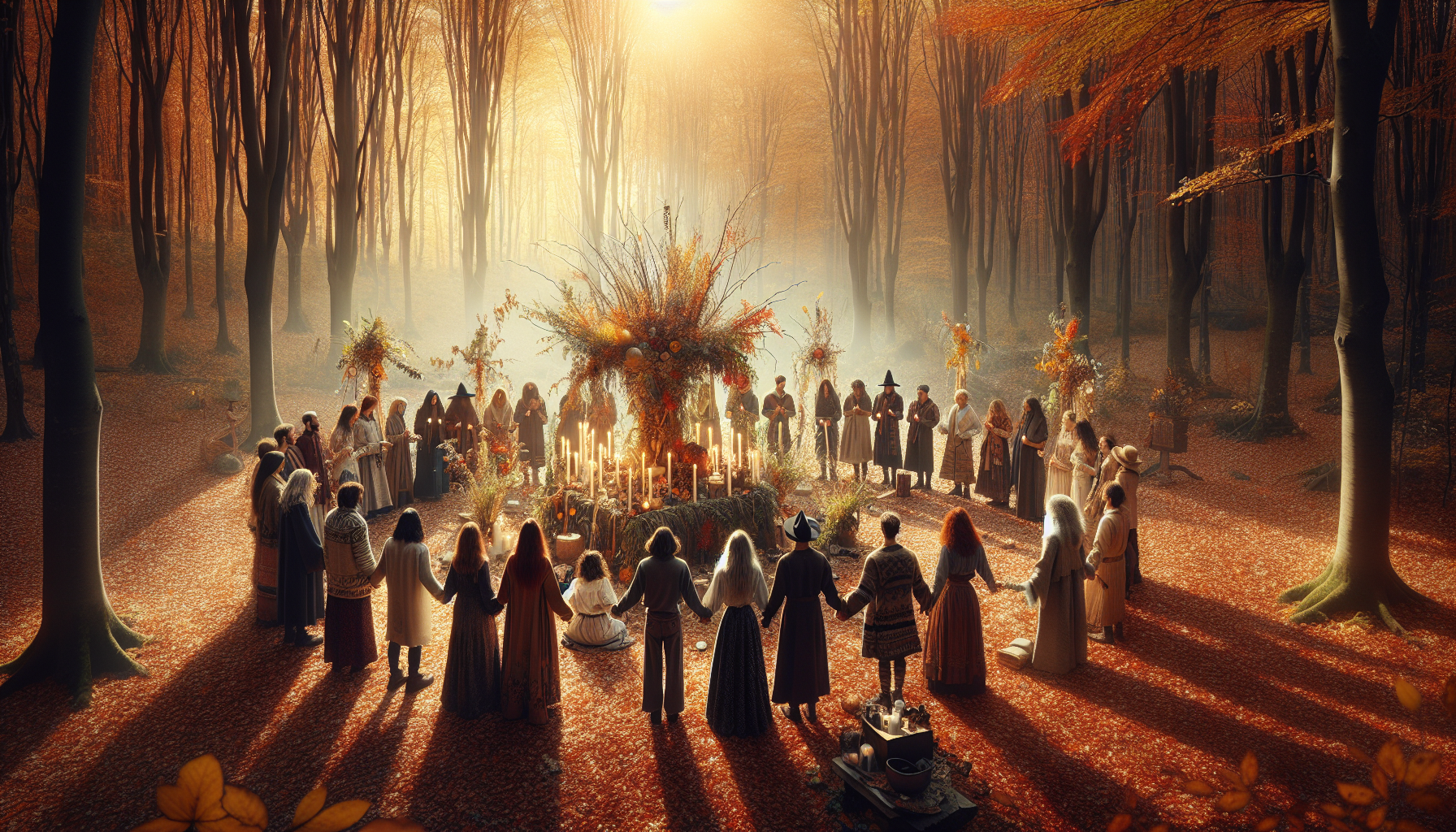In the vast and intricate tapestry of the natural world, few phenomena capture the imagination quite like animal mimicry. This captivating survival strategy, where creatures imitate the appearance, sounds, or behaviors of other species or their environments, reveals the astonishing ingenuity of life on Earth. From the vibrant forests of the Amazon to the mysterious depths of the oceans, mimicry serves as both a shield and a weapon in the daily struggle for survival. It’s a dance of deception and disguise, a language without words, where the stakes are life and death. Through mimicry, animals communicate complex messages that can mean the difference between being prey or predator, visible or invisible. 🌿
But why, you might wonder, do animals go to such great lengths to impersonate others? The answers are as diverse as the ecosystems these creatures inhabit. Mimicry can serve multiple purposes, such as avoiding predators, luring prey, or even facilitating reproduction. This fascinating adaptation not only showcases the incredible versatility and creativity of nature but also challenges our understanding of communication itself. In a world where appearance can be everything, mimicry blurs the lines between reality and illusion, prompting us to question what we see and what it means to survive.
Throughout this article, we will explore the many faces of animal mimicry, delving into the science behind this remarkable evolutionary strategy. We will examine some of the most astounding examples of mimicry in the animal kingdom, from the masterful camouflage of the cuttlefish to the cunning tactics of the mimic octopus. Along the way, we will uncover the mechanisms that make mimicry possible, including the evolutionary pressures that drive species to adapt in such intricate ways. 🐙
Understanding Animal Mimicry
Animal mimicry is a captivating phenomenon that plays a crucial role in the survival and communication strategies of various species. This fascinating adaptation involves one organism evolving to share similar characteristics with another, whether it be in appearance, sound, behavior, or scent. Mimicry serves as an essential tool in the natural world, enabling species to protect themselves from predators, deceive prey, or even communicate with their own kind. The diverse strategies and purposes of mimicry make it a rich subject of study for scientists and nature enthusiasts alike. 🦋🐍
At its core, mimicry can be divided into several categories, each serving distinct functions in nature. The most well-known types are Batesian mimicry, Müllerian mimicry, and aggressive mimicry. Batesian mimicry involves a harmless species imitating the warning signals of a harmful one to deter predators. Müllerian mimicry, on the other hand, occurs when two or more harmful species evolve to resemble each other, reinforcing their warning signals to shared predators. Aggressive mimicry involves predators or parasites imitating something benign or attractive to lure their prey or hosts. This intricate dance of imitation is not only a testament to the creativity of evolution but also an indication of the intricate web of interactions in ecosystems.
Batesian Mimicry: The Art of Deception
Batesian mimicry, named after the British naturalist Henry Walter Bates, is a form of mimicry where a harmless species evolves to imitate the warning signals of a harmful species. This clever adaptation allows the mimic to benefit from the predator’s aversion to the dangerous model, thereby increasing its chances of survival. Batesian mimicry is prevalent in the animal kingdom and can be found in various forms, from visual resemblance to auditory mimicry.
A classic example of Batesian mimicry is the relationship between the monarch butterfly and the viceroy butterfly. The monarch is known for its toxic nature, resulting from its diet of milkweed during its larval stage. Predators that have experienced the unpleasant taste or toxicity of monarchs tend to avoid them. The viceroy, which is non-toxic, has evolved to closely resemble the monarch in coloration and pattern. This visual mimicry effectively deters predators, as they mistake the viceroy for the unpalatable monarch. 🦋
Another fascinating case of Batesian mimicry can be observed in the world of snakes. The scarlet kingsnake, which is non-venomous, has evolved to mimic the bright coloration of the venomous coral snake. By adopting similar red, yellow, and black banding patterns, the scarlet kingsnake can avoid predation by creatures that have learned to steer clear of the deadly coral snake. The phrase “red touch yellow, kill a fellow; red touch black, venom lack” is a mnemonic device often used to distinguish between these two snakes. Despite its simplicity, Batesian mimicry showcases the intricate evolutionary arms race between predators and prey.
Müllerian Mimicry: Mutual Benefit
In contrast to Batesian mimicry, where a harmless species benefits from mimicking a harmful one, Müllerian mimicry involves two or more harmful species that have evolved to resemble each other. This form of mimicry, named after the German naturalist Fritz Müller, is a mutually beneficial strategy that reinforces warning signals to predators. As a result, predators learn more quickly to avoid any species with similar warning coloration, leading to a collective increase in survival rates for all involved species.
A quintessential example of Müllerian mimicry is found among the heliconius butterflies, a diverse group of brightly colored butterflies known for their toxic properties. Different species within this group often share similar color patterns and markings, creating a cohesive visual signal to potential predators. By sharing a common warning signal, these butterflies can collectively reinforce their deterrent effect, reducing the likelihood of being attacked. This shared defense mechanism exemplifies how cooperation can emerge in nature, even among different species.
Similarly, Müllerian mimicry can be seen in the realm of amphibians. Poison dart frogs, known for their vivid colors and toxic secretions, often display Müllerian mimicry. Different species of poison dart frogs within the same habitat may exhibit similar color patterns, enhancing the learning process for predators. As predators learn to associate specific coloration with toxicity, all species involved benefit from the increased avoidance behavior.
The principle of Müllerian mimicry extends beyond visual signals and can include other forms of warning, such as chemical or auditory cues. This multifaceted approach to mimicry underscores the complexity of evolutionary strategies and highlights the interconnectedness of species within ecosystems.
Comparative Table: Batesian vs. Müllerian Mimicry
| Aspect | Batesian Mimicry | Müllerian Mimicry |
|---|---|---|
| Species Involved | Harmless species mimics harmful one | Harmful species mimic each other |
| Benefit | Harmless species gains protection | Mutual benefit for all mimics |
| Learning Curve for Predators | Relies on predators learning to avoid harmful model | Predators learn to avoid all mimics faster |
| Example | Viceroy mimicking Monarch | Heliconius butterflies |
To explore the complexities of mimicry further, consider watching this insightful video: “The Art of Animal Mimicry” by Science Channel. 📺
Aggressive Mimicry: Predators in Disguise
Aggressive mimicry represents a cunning strategy employed by predators or parasites to deceive their prey or hosts. Unlike Batesian and Müllerian mimicry, which primarily serve defensive purposes, aggressive mimicry is a form of offensive adaptation. In this intriguing form of mimicry, the predator or parasite resembles something harmless, attractive, or beneficial to its target, thereby gaining an advantage in capturing or exploiting its prey.
One remarkable example of aggressive mimicry can be found in the anglerfish, a deep-sea predator known for its unique hunting technique. The anglerfish possesses a specialized appendage on its head that acts as a lure, resembling a small fish or worm. This bioluminescent lure attracts unsuspecting prey, drawing them close enough for the anglerfish to strike. By mimicking a harmless or enticing object, the anglerfish effectively deceives its prey, ensuring a successful hunt in the dark depths of the ocean. 🎣
Similarly, the cuckoo bird employs aggressive mimicry in its parasitic reproductive strategy. Female cuckoos lay their eggs in the nests of other bird species, relying on the host parents to incubate and raise their young. The cuckoo egg often mimics the appearance of the host’s eggs, reducing the likelihood of detection and rejection. Once hatched, the cuckoo chick may even mimic the begging calls of the host’s own offspring, further deceiving the host parents into providing care and resources. This sophisticated form of mimicry allows the cuckoo to offload the costs of parental care onto unsuspecting hosts.
Aggressive mimicry showcases the ingenious tactics developed by predators and parasites in the ongoing evolutionary arms race. By blending deception with opportunity, these species exploit the trust and vulnerabilities of their targets, underscoring the complex dynamics of predator-prey interactions.
The Broader Implications of Animal Mimicry
Animal mimicry extends far beyond individual survival strategies, influencing broader ecological and evolutionary processes. The diverse forms of mimicry observed in nature reflect the intricate interconnections between species, highlighting the importance of adaptation and innovation in the face of environmental challenges. Mimicry not only facilitates survival and reproduction but also shapes the structure and dynamics of ecosystems.
One intriguing aspect of mimicry is its role in driving coevolution, the reciprocal evolutionary change between interacting species. As predators and prey engage in an ongoing arms race, mimicry can lead to the development of more sophisticated adaptations on both sides. For instance, as prey species evolve to better mimic harmful models, predators may develop heightened discrimination abilities to detect the mimics. This dynamic interplay fosters a continuous cycle of adaptation and counter-adaptation, driving the diversification of traits and behaviors within ecosystems.
Mimicry also influences ecological interactions and community dynamics. In cases of Müllerian mimicry, the reinforcement of warning signals can lead to changes in predator behavior, ultimately affecting prey populations and species composition. Similarly, aggressive mimicry can impact prey populations by altering predation rates and influencing prey behavior. These interactions have cascading effects on food webs and ecosystem stability, underscoring the ecological significance of mimicry.
- Mimicry as a driver of coevolution
- Influence on predator-prey dynamics
- Impact on ecosystem stability and biodiversity
The study of animal mimicry offers valuable insights into the mechanisms of evolution, adaptation, and ecological interactions. By unraveling the secrets of mimicry, researchers gain a deeper understanding of the complex tapestry of life on Earth, inspiring both scientific inquiry and conservation efforts.
As you continue to explore the wonders of animal mimicry, remember to appreciate the creativity and ingenuity of nature’s adaptations. The language of survival and communication in the animal kingdom is a testament to the power of evolution and the remarkable strategies that have emerged over millennia. 🐢🌿

Conclusion
Unlocking the Secrets of Animal Mimicry: The Fascinating Language of Survival and Communication has taken us on an enthralling journey through the intricate world of mimicry in the animal kingdom. We’ve explored the diverse strategies and forms of mimicry, from Batesian and Müllerian mimicry to aggressive and sexual mimicry, revealing how these fascinating adaptations serve as powerful tools for survival, communication, and evolution. This topic, rich in complexity and intrigue, underscores the marvel of natural selection and the endless creativity of life on Earth.
Animal mimicry is not just a curious spectacle for naturalists and scientists but a profound demonstration of life’s resilience and adaptability. Through mimicry, species can avoid predators, attract mates, and even deceive prey. We delved into the mechanisms and evolutionary pressures that have shaped these remarkable adaptations, revealing a world where imitation is not only the sincerest form of flattery but a critical strategy for survival. For instance, the striking resemblance of the harmless hoverfly to the stinging wasp is a classic example of Batesian mimicry, which we’ve discussed in detail, highlighting its role in predator avoidance and survival.
The article also emphasized the importance of Müllerian mimicry, where harmful species evolve to resemble each other, thereby reinforcing avoidance behavior in predators. This mutualistic strategy showcases the interconnectedness of species and the cooperative aspects of evolution, illustrating that sometimes, survival is a team effort.
Moreover, we’ve touched upon the captivating phenomenon of aggressive mimicry, where predators or parasites imitate harmless or beneficial species to deceive their targets. This strategy, as seen in anglerfish and certain orchid species, is a testament to the cunning and deceptive strategies life has developed in the relentless pursuit of survival.
Sexual mimicry was another fascinating facet explored, revealing how mimicry is employed in the complex dance of reproduction and mate selection. By resembling other species or genders, organisms can gain reproductive advantages, thus ensuring the continuation of their genes.
The insights gained from studying mimicry extend beyond biology, offering valuable lessons for fields such as robotics, artificial intelligence, and even cybersecurity, where mimicry and deception can play pivotal roles. The principles observed in nature can inspire innovative solutions to human challenges, demonstrating that the study of nature’s language of survival and communication is not just academically enriching but practically beneficial.
Understanding mimicry in the animal kingdom also invites us to reflect on our own place in the natural world. It challenges us to appreciate the delicate balance of ecosystems and the intricate relationships that sustain life. By learning from these natural strategies, we can foster a deeper connection with the environment and cultivate a more harmonious existence with the myriad forms of life that share our planet.
As we conclude this exploration, it’s vital to recognize the significance of preserving biodiversity. The loss of any species due to habitat destruction or climate change could mean the disappearance of unique mimicry strategies that have taken millions of years to evolve. Conservation efforts are crucial not only for the survival of individual species but for the preservation of the rich tapestry of life that sustains our planet.
We encourage you, dear reader, to take these insights and apply them in your own life. Whether it’s fostering a greater appreciation for nature, supporting conservation efforts, or exploring how mimicry can inspire innovation in various fields, your engagement can make a difference. Share these fascinating discoveries with others, spark discussions, and inspire action. 🐦
Your curiosity and passion for understanding the natural world are vital for driving change and ensuring the continued study and preservation of these extraordinary phenomena. Let us embrace the lessons nature offers and work together to protect the wonders of the animal kingdom for future generations.
Thank you for joining us on this journey into the world of animal mimicry. We hope it has been as enlightening and inspiring for you as it has been for us. Feel free to leave your thoughts, share your experiences, or ask questions in the comments below. Let’s continue this conversation and explore the myriad ways we can learn from the amazing world of mimicry.
For further reading and exploration, consider visiting and . These resources offer a wealth of information and stunning visuals that further illustrate the captivating world of mimicry.
Together, let’s celebrate the ingenuity of nature and strive to unlock even more of its secrets. 🌿
Gabriel is a visual storyteller and symbolic naturalist whose creations explore the veiled ecologies and ancestral ties between humans and the living world, as echoed through myth and memory. With a sensitivity attuned to the sacred, Gabriel unveils the ancient choreography of plant, animal, and spirit — a realm where forests spoke in signs, rivers kept secrets, and every flower bore a forgotten name.
His path winds through the esoteric — tracing the rituals of forest sages, the herbal codes of ancestral healers, and the silent agreements that once guided human life in deep reciprocity with nature. From moss-covered shrines to twilight groves, Gabriel’s work reveals relationships once vital, now buried beneath layers of modern detachment.
With a foundation in visual design and the aesthetics of ancestral wisdom, Gabriel weaves storytelling into sacred ecology. His work doesn’t just depict — it channels. Drawing from myth, mysticism, and lost herbal traditions, he crafts images and narratives that pulse with the old knowing: that nature is not scenery, but kin and teacher.
Through collections of symbolic visuals, myth-rooted studies, and intuitive reflections, Gabriel invites others to rekindle forgotten senses — to listen not only with ears, but with intuition, memory, and reverence.
His work is a tribute to:
-
The mythic language of trees, stones, and roots
-
Forgotten pacts between healers and the wild
-
The sacred intelligence in nature’s unseen patterns
Whether you walk with the lore of plants, dream with the rhythms of the earth, or simply feel the call of something older in the wind through the leaves, Gabriel welcomes you into a space where symbolism, spirit, and wild nature entwine — one myth, one leaf, one vision at a time.





